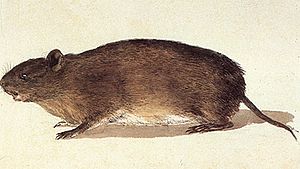Guiara
| Guirara | ||||||||||||
|---|---|---|---|---|---|---|---|---|---|---|---|---|

Guirara ( Euryzygomatomys spinosus ) |
||||||||||||
| Systematics | ||||||||||||
|
||||||||||||
| Scientific name of the genus | ||||||||||||
| Euryzygomatomys | ||||||||||||
| Goeldi , 1901 | ||||||||||||
| Scientific name of the species | ||||||||||||
| Euryzygomatomys spinosus | ||||||||||||
| ( Fischer von Waldheim , 1814) |
The guirara ( Euryzygomatomys spinosus ) is a rodent in the spiny rat family . The species is currently (2014) listed as the only representative of the thus monotypic genus Euryzygomatomys . A division of the taxon into two or more species is likely required.
features
With a head-torso length of 17 to 27 cm and a tail length of 5.0 to 5.5 cm, the Guirara is a medium-sized spiny rat. She has a stocky build and short ears. Males are generally taller than females, weighing between 165 to 210 g. The fur on the upper side is made up of soft hair and spines, it is colored agouti- brown. The soft underside, on the other hand, is white. There are strong claws on the toes .
Distribution and way of life
The Guirara inhabits the Cerrado savannah and northern areas of the pampas in southeast Brazil as well as in neighboring areas of Paraguay and Argentina . The species was also found on the edges of forests.
The way of life is only partially explored. A study from 1992 describes the species as nocturnal with a diet consisting mainly of fruits or other parts of plants. Another study from 2007 documents damage to tree bark. The Guirara digs tunnels in the ground. Pregnant females had one to three embryos.
status
No significant threats are known to the Guirara. It is listed as Least Concern by the World Conservation Union (IUCN) .
Individual evidence
- ↑ Don E. Wilson , DeeAnn M. Reeder (Ed.): Mammal Species of the World . A taxonomic and geographic Reference . 3. Edition. 2 volumes. Johns Hopkins University Press, Baltimore MD 2005, ISBN 0-8018-8221-4 (English, Euryzygomatomys ).
- ↑ a b c Euryzygomatomys spinosus in the IUCN Red List of Threatened Species 2014.3. Posted by: Catzeflis, F., Patton J., Percequillo, A., Bonvicino, C. & Weksler, M., 2008. Retrieved March 6, 2015.
- ^ A b c Ronald M. Nowak: Walker's Mammals of the World. Volume 2. 6th edition. 1999, p. 1690, ISBN 0-8018-5789-9 .
- ^ Eisenberg & Redford (Eds.): Mammals of the Neotropics . tape 3 . University of Chicago Press, 2000, ISBN 0-226-19542-2 , pp. 480 (English, Euryzygomatomys ).
- ↑ Gonçalves et al. (2007) Bark consumption by the spiny rat Euryzygomatomys spinosus